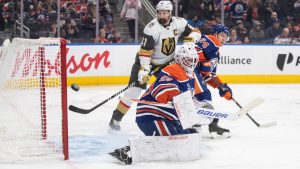Can a $10 million AAV be a bargain?
In Aleksander Barkov‘s case, it might be true.
The Florida Panthers centre signed a maximum term, eight-year contract extension on Friday. Had this piece of business not been finished, questions about Barkov’s future would have been front of mind all season for Panthers fans, as he was set to become a UFA next summer.
And you can bet had that happened, he would have pulled in more than $10 million.
Barkov is one of the rare elite forces at both ends of the ice, at the peak of his game. Last season’s Selke Trophy winner, Barkov’s defensive game has been lauded for years and his offensive contributions have been elevated. Since his breakout 96-point season in 2018-19, Barkov ranks 16th in NHL points per game (1.09).
This could have been a market-setting contract for centres selling only UFA years. Barkov probably was never going to come in higher than Connor McDavid’s $12.5 million, especially within the current climate, but certainly could have challenged John Tavares‘ $11 million or even Auston Matthews’ $11.6 million (signed as an RFA) had he pushed the envelope. The fact Florida is a state without income tax has helped the Tampa Bay Lightning keep costs of their best players down and, perhaps, that was at play here for Barkov, too.
The immediate reaction in these parts was how bad, again, this makes the Leafs look for how much they paid Tavares, Matthews and Mitch Marner. There are different factors at play here, and those deals were signed when the cap was still projected to rise. Remove the Leafs from this, though, and you’ll see that on an NHL scale Barkov’s contract is a huge value win for the Panthers.
Here’s how Barkov’s deal stacks up to comparable centres.
(All contract figures are via CapFriendly.)
John Tavares
Contract: Seven years, $11 million AAV
Signing Date: July 1, 2018
Cap Hit Percentage At Time Of Signing: 13.84
Prior to the pandemic, doing cap comparable pieces was rather direct. The cap would rise and be projected to do so every year, so values would increase slightly with it. There was an overall market you could compare contracts within, but it was important to understand that the landscape was always changing and trending up.
In a flat cap reality, it’s harder to have a rise in player costs. And indeed, when Alex Pietrangelo signed in Vegas as a UFA in October of 2020, or when Dougie Hamilton signed with the New Jersey Devils this off-season, they didn’t re-set the market. Their contracts came in under Erik Karlsson, P.K. Subban, Drew Doughty and Roman Josi, who all signed pre-COVID.
So an important number to consider when comparing how a contract stacks up is cap hit percentage at the time of signing. At the time of Barkov’s signing, his $10 million AAV (which doesn’t actually kick in until next season) is 12.27 per cent of an $81.5 million salary cap (remember that number).
Tavares is a great comparison here, because he was at the exact same place in his career when he left the Islanders as Barkov would have been had he hit the UFA market next summer. Tavares, with less upside on the defensive side, signed for a cap percentage much larger than what Barkov did, and for a higher straight away AAV.
Had Barkov signed today for the same 13.84 cap percentage that Tavares did in 2018, the Panthers captain would have an $11.3 million AAV that would make him the third-highest paid centre in the game and not been an egregious overpay.
Bargain.
Jonathan Toews
Contract: Eight years, $10.5 million AAV
Signing Date: July 9, 2014
Cap Hit Percentage At Time Of Signing: 15.22
Toews was one of the top defensive forwards when he signed this, his third NHL contract, in 2014. He had also won a couple of Stanley Cups, but didn’t have the same offensive contributions to his game that Barkov does.
The cap was rising of course, but 15.22 per cent spent on one player? No one eclipsed that until McDavid reset everything when he signed his $12.5 million extension with the Oilers (at 16.7 per cent of the cap).
Toews’ deal, in context, is more comparable to McDavid’s than anyone else’s. And had Barkov dug in his heels to seek a similar cap impact contract to what Toews got, well then, 15.22 per cent of an $81.5 million cap is $12.4 million and that certainly would have been market setting in the pandemic.[sidebar]
Jack Eichel
Contract: Eight years, $10 million AAV
Signing Date: October 3, 2017
Cap Hit Percentage At Time Of Signing: 13.33
Eichel is slightly different because he signed this extension straight out of his entry-level contract so, unlike Barkov, Toews and Tavares, some RFA years were being bought up with this contract. In theory, that keeps the price down somewhat.
He signed this deal with Buffalo after just two NHL seasons and without a true breakout campaign yet. He hadn’t been a point per game player, but his pedigree and trajectory were obvious. Prior to his neck injury and the ensuing fallout with the Sabres organization, Eichel was meeting expectations of this deal.
But, again, this points out how much of a steal Barkov’s contract is, considering it only buys up UFA years. A 13.33 cap hit percentage of an $81.5 million ceiling is $10.9 million.
Another reason why Barkov’s contract is such a bargain for the Panthers.
Anze Kopitar
Contract: Eight years, $10 million AAV
Signing Date: January 16, 2016
Cap Hit Percentage At Time Of Signing: 14.01
As player comparisons go, Kopitar might be the best on this list to put side by side with Barkov. This contract was Kopitar’s third with the Kings and it was signed in the middle of the 2015-16 season, which was also the one in which Kopitar won his first Selke Trophy. Everyone saw that award coming his way eventually, and he won it again in 2017-18.
Kopitar also did have the same sort of offensive contributions that Barkov has. Kopitar never scored 96 points, but he was on his way to his sixth 70-plus point season in 2015-16.
As you can see, though, a 14.01 per cent cap charge is well above what the Panthers had to invest in Barkov. In today’s cap world, that amounts to just over $11.4 million, which would have made Barkov the third-highest paid centre just behind Auston Matthews. Perhaps this is the number we should have expected to value Barkov at in a vacuum. It wouldn’t have been an overpayment to reach this far.
Again, what a bargain.
Barkov’s new deal — which kicks in next season — is tied with Kopitar and Eichel as the fifth-highest cap hits among all centres. But comb that back and measure by cap hit percentage at the time of signing and Barkov’s 12.27 per cent comes in 10th, behind even Tyler Seguin.
And keep in mind that while the cap has been flat for a couple of years now, there are suggestions it could start rising by $1 million per year as soon as next season. Within three years, we could start seeing the cap rise by even more. There aren’t many avenues to this ever being a truly bad contract.
Now if only the Panthers could figure out how to get out from under Sergei Bobrovsky’s albatross of a contract…
[relatedlinks]




